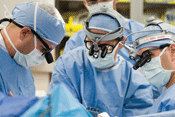|
 For patients diagnosed with epilepsy, medical management is the first line of treatment. However, some patients learn
that their epilepsy is medically intractable, and their continued seizures can be damaging to their safety, development
and quality of life. When patients fail to respond to two or more medications, epilepsy surgery can be a highly effective
treatment option. These patients should be referred to a center specializing in the pre-operative evaluation and surgical
treatment of these patients, such as the Cleveland Clinic Epilepsy Center.
For patients diagnosed with epilepsy, medical management is the first line of treatment. However, some patients learn
that their epilepsy is medically intractable, and their continued seizures can be damaging to their safety, development
and quality of life. When patients fail to respond to two or more medications, epilepsy surgery can be a highly effective
treatment option. These patients should be referred to a center specializing in the pre-operative evaluation and surgical
treatment of these patients, such as the Cleveland Clinic Epilepsy Center.
Multidisciplinary management and state-of-the-art monitoring
Cleveland Clinic's world-renowned team of experts
collaborates to determine which patients are eligible for surgery. This highly skilled team includes:
- epileptologists,
- neurosurgeons,
- neuropsychologists,
- technologists and
- social workers.
Epilepsy surgery typically involves the removal of the region of the brain responsible for the abnormal electrical
signals that cause seizures (the epileptogenic zone). Cleveland Clinic's surgical evaluation begins with patient
monitoring in their state-of-the-art 10-bed adult epilepsy monitoring unit or eight-bed dedicated pediatric epilepsy
monitoring unit, both of which run 24/7 and feature all-digital video EEG equipment.
Other imaging modalities used to precisely locate the epileptogenic zone include:
- high-resolution MRI,
- functional MRI (fMRI),
- magnetic resonance spectroscopy (MRS),
- ictal single-photon-emission computed tomography (SPECT),
- positron emission tomography (PET) and
- diffusion tensor imaging (DTI).
Cleveland Clinic now also offers magnetoencephalography (MEG), the most advanced way to noninvasively measure electrical brain
activity. This sophisticated imaging modality is offered by only a handful of centers in the country.
A variety of surgical techniques with excellent outcomes
Once the epileptogenic zone is identified and patients are determined to be candidates for surgery, the Cleveland Clinic Epilepsy
Center team determines the best resective approach, including
- extra-temporal surgery,
- hemispherectomy,
- lesionectomy or
- temporal lobectomy.
For patients where a focal onset within the brain cannot be identified, surgical options are still available, including brain
stimulation and disconnection of the two hemispheres via corpus callostomy to reduce the severity of the seizures. About 300
adult and pediatric patients receive epilepsy surgery in 2008 at Cleveland Clinic, which has been performing the surgery for
the past three decades.
Cleveland Clinic's experienced staff, modern diagnostic modalities, rigorous selection processes and well-honed surgical techniques
are reflected in their exceptionally favorable outcomes. Two years after surgery, 75 percent of patients who underwent temporal
lobectomy were completely seizure-free, compared with the national average of 72 percent. Ten years post-op, 68 percent of Cleveland
Clinic patients remained seizure-free, compared with the reported national average of 51 percent. *
* National seizure-free rates represent a weighted average of recent studies conducted in the United States and published in Epilepsia,
JAMA: the Journal of the American Medical Association, Military Medicine and Neurology.
|




 For patients diagnosed with epilepsy, medical management is the first line of treatment. However, some patients learn
that their epilepsy is medically intractable, and their continued seizures can be damaging to their safety, development
and quality of life. When patients fail to respond to two or more medications, epilepsy surgery can be a highly effective
treatment option. These patients should be referred to a center specializing in the pre-operative evaluation and surgical
treatment of these patients, such as the Cleveland Clinic Epilepsy Center.
For patients diagnosed with epilepsy, medical management is the first line of treatment. However, some patients learn
that their epilepsy is medically intractable, and their continued seizures can be damaging to their safety, development
and quality of life. When patients fail to respond to two or more medications, epilepsy surgery can be a highly effective
treatment option. These patients should be referred to a center specializing in the pre-operative evaluation and surgical
treatment of these patients, such as the Cleveland Clinic Epilepsy Center.